This Week’s Guest Blogger is Stacy Cronly-Dillon a beekeeper who offers courses at Sunnyfields Apiaries on the Norfolk/Suffolk border

Building a pollinator friendly patch.
Elizabeth Lawrence (garden writer) wrote “the hum of bees is the voice of the garden” which is written on a plaque in my own garden, where honey bees, bumblebees and solitary bees all live in harmony enjoying the blossoms produced by the many plants that fill our outdoor space.
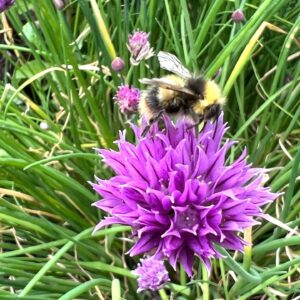
Where in the garden you’ll find the bees, depends on what time of year it is. In spring the dead nettles are allowed to flower in patches and this is glorious forage for the bumblebees who come in all shapes and sizes to visit the tiny flowers, this is whilst the honey bees visit the pollen rich willow trees and hawthorn hedgerows; preferring the plants that produce flowers full of pollen and nectar en-masse. By summer the bumblebees are bouncing from flower to flower, enjoying the lawn filled with clover and buttercups, the lavender bushes, and foxgloves. The bumblebee’s tongue being long enough to reach the sweet syrup deep within the foxglove’s flower whilst the honey bees are searching for simpler flowers with more direct access to their food supply.
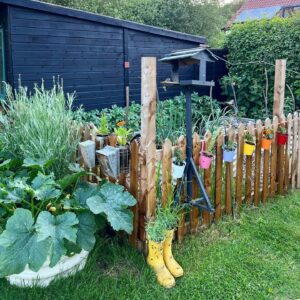
When we moved to our house in 2021 we inherited a garden that was overgrown and wild with signs of previous love that time had started to strangle. The plot is just over three quarters of an acre, surrounded by fields on three sides and a woodland on the third. Our plan is (as we’re still working on it) to find a balance between wilderness and beauty. To allow nature some freedom whilst also having a space that is productive and attractive. The reason for this is our desire to create a healthy ecosystem where the use of weed killers and insecticides is banned, where the ‘pests’ have predators, where insects are encouraged and where we can also enjoy the space that provides food and relaxation for us and our pets.
We’ve started in a corner we call the “productive garden” and I also call “Jurassic park” because it’s where the beehives are situated (bees have been around for millions of years), as well as the chickens (our own mini-dinosaurs).
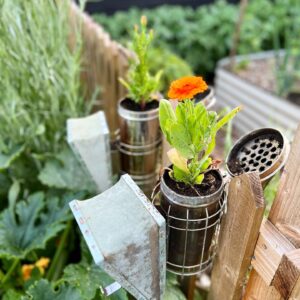
Along with the honey bees and chickens we have built a veg garden using raised beds, this is because the ground gets very waterlogged and is on a slight slope, digging down wasn’t really an option. Within the raised beds we are growing vegetables alongside pollinator friendly and pest controlling flowers such as borage, nasturtiums, sweet peas and marigolds, and follow the no-dig process.
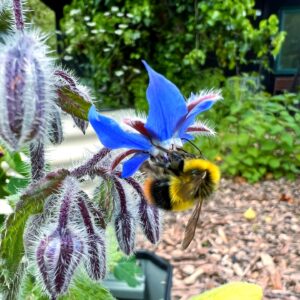
To further reduce the waterlogging we’ve started to grow the grass longer with variations on length throughout the area. In some places it’s cut to a height of a couple of inches where the clover and buttercups flourish and then we have sections which are only cut a couple of times a year, creating corridors and hiding places for wildlife as well as nesting sites. Dave Goulson Author, and Professor of Biology at University of Sussex specialising in bee ecology, suggests in his book “the garden jungle” that mowing paths through the longer grass creates a sense of order and this is completely true, some wavy paths through and around the long grass provides a neatness that we seem to desire in our gardens, whilst allowing the garden to thrive.
Within this garden we have some outbuildings which have been fitted with drainpipes leading to a series of water butts. This is used to water the gardens during the dry spells but is also used to top up the watering stations we have around the plot for the wildlife and of course bees. For the bees we add stones to a saucer of water which gives them little islands to stand on and drink from.
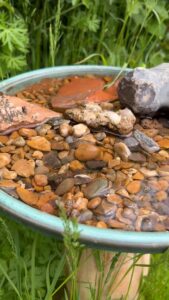
We also have a natural pond which we ensure has a path down to it for the deer, hedgehogs, pheasants and other garden critters to drink from. Providing plenty of water sources within the garden is so important with our summers becoming warmer and dryer and watering the plants during these dry spells is also crucial as if plants get too dry they reserve their resources in order to survive, and so stop producing nectar which is an essential food source for many insects but particularly bees.
The final piece of the puzzle for our productive patch is the provision of additional nesting sites for the insects; we’ve got the food and drink covered so places to make a home or lay eggs is next on the priority list. For this we have a variety of options – the wild areas work for some and we leave areas with stems and piles of leaves over the winter months. We have piles of sticks and bricks which also provide protective areas to hide and rest. We also have wildlife ‘hotels’ specifically for solitary bees and wasps which are hung on sunny walls where we observe the mason bees, leafcutter bees and ruby-tailed wasps laying their eggs.

We started working on the ‘productive garden’ last year and this year we’ve noticed more species of bee visiting than usual this year already, the insect hotels are putting up “no vacancy signs” as have been filled and the veg plot is starting to find a balance. It’s all a work in progress but it’s a clear sign that we can all work with nature to produce beautiful gardens that work in harmony with nature.
Stacy Cronly-Dillon is a professional beekeeper and owner of Sunnyfields Apiaries, a training and education business based on the Suffolk/ Norfolk border. She runs bee experiences and beginner beekeeper training, as well as speaking to groups and organisations about the wonders of bees, around the country. To learn more visit www.sunnyfieldsbees.com
